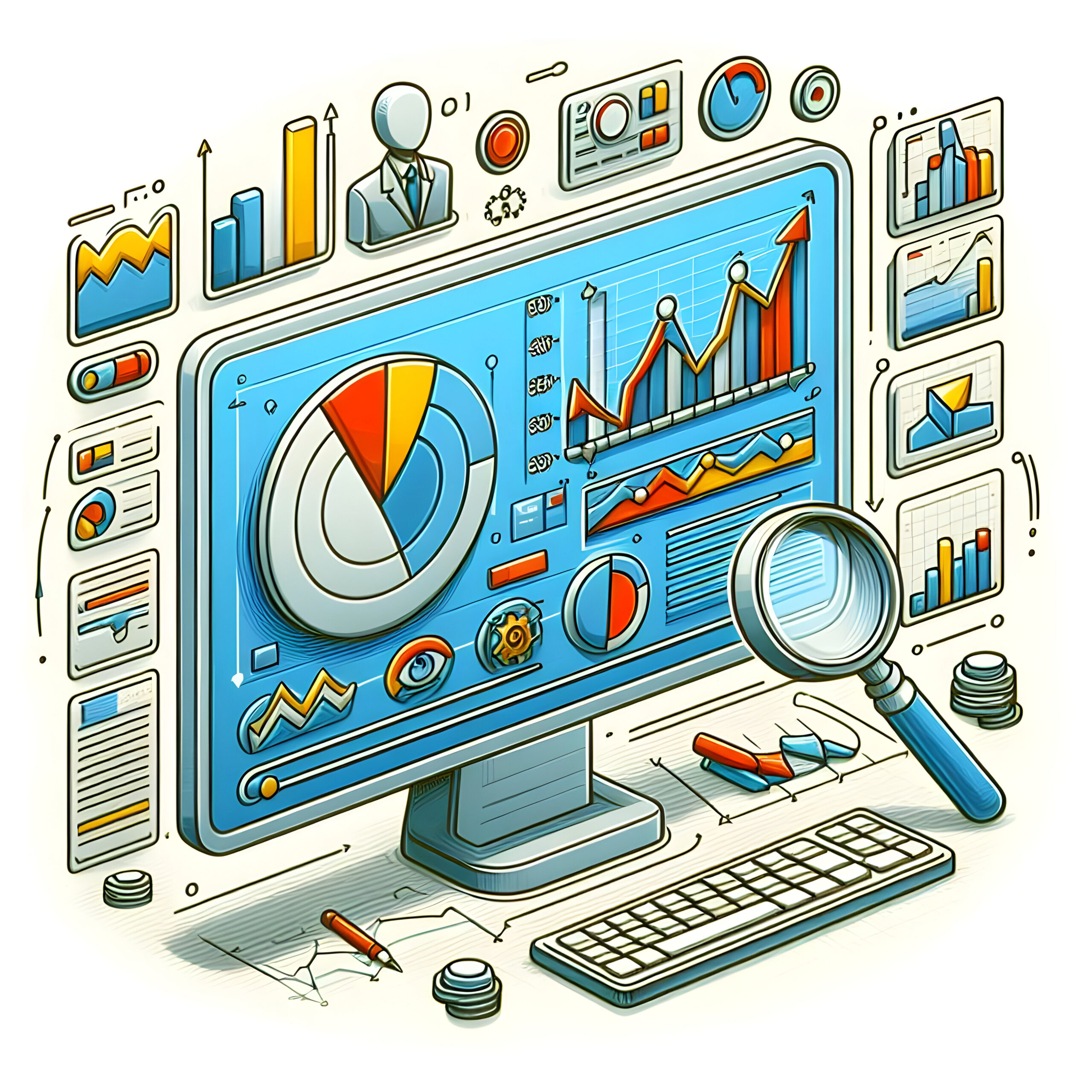7 Essential Business Research Tools and Techniques for Market Domination
In today’s fiercely competitive business landscape, mastering business research tools and techniques is crucial for market domination.
As companies strive to stay ahead of the curve, the ability to gather, analyze, and interpret data has become a cornerstone of success.
This article delves into seven essential business research tools and techniques that can propel your organization to new heights.
By harnessing these powerful methods, you’ll be equipped to make informed decisions, identify emerging trends, and outmaneuver your competitors.
Whether you’re a startup founder, a seasoned executive, or a marketing professional, understanding and implementing these business research tools and techniques will give you a significant edge in your industry.
From cutting-edge digital platforms to time-tested analytical frameworks, we’ll explore a diverse range of approaches that cater to various business needs and objectives.
So, let’s dive into the world of business research tools and techniques and discover how they can transform your market strategy and drive sustainable growth.
We strongly recommend that you check out our guide on how to take advantage of AI in today’s passive income economy.
Table of Contents
1. Advanced Market Research Surveys
Harnessing the Power of Customer Insights
Among the most valuable business research tools and techniques, advanced market research surveys stand out for their ability to tap directly into customer sentiment.
These sophisticated questionnaires go beyond simple yes-or-no queries, employing a mix of quantitative and qualitative questions to paint a comprehensive picture of your target audience.
By utilizing advanced survey platforms like Qualtrics or SurveyMonkey, businesses can design complex, branching questionnaires that adapt based on respondents’ answers.
This dynamic approach allows for a more nuanced understanding of customer preferences, pain points, and buying behaviors.
Moreover, these platforms often come equipped with powerful analytics tools, enabling researchers to identify patterns and correlations that might otherwise go unnoticed.
When crafting your surveys, it’s crucial to strike a balance between depth and respondent fatigue.
Consider using a mix of multiple-choice, Likert scale, and open-ended questions to gather both structured data and rich, qualitative insights.
Leveraging AI for Survey Analysis
The true power of advanced market research surveys lies not just in data collection, but in the analysis phase.
Modern business research tools and techniques incorporate artificial intelligence and machine learning algorithms to sift through vast amounts of survey data.
These AI-powered tools can identify trends, segment respondents based on various criteria, and even predict future behaviors based on survey responses.
By employing sentiment analysis, businesses can gauge emotional responses to products or services, providing invaluable insights for product development and marketing strategies.
Furthermore, advanced visualization tools allow researchers to present survey findings in compelling, easy-to-understand formats.
This makes it easier for decision-makers to grasp complex data points and act on the insights gleaned from the surveys.
When implementing advanced market research surveys, it’s essential to ensure data privacy and compliance with regulations like GDPR.
2. Social Media Listening Tools
Tapping into the Digital Pulse of Your Market
In the realm of business research tools and techniques, social media listening tools have emerged as indispensable assets for modern enterprises.
These powerful platforms allow businesses to monitor, analyze, and respond to conversations happening across various social media channels in real-time.
By tuning into these digital discussions, companies can gain unfiltered insights into customer opinions, track brand sentiment, and identify emerging trends before they hit the mainstream.
Popular tools like Brandwatch, Hootsuite Insights, and Sprout Social offer comprehensive solutions for social media monitoring and analysis.
These platforms use advanced algorithms to sift through millions of social media posts, comments, and interactions, providing businesses with actionable intelligence.
By leveraging natural language processing, these tools can categorize mentions, gauge sentiment, and even detect sarcasm or irony in posts.
This level of nuanced analysis is crucial for understanding the true impact of your brand in the digital sphere.
From Monitoring to Strategic Action
The true value of social media listening tools lies in their ability to transform raw data into strategic insights.
These business research tools and techniques allow companies to track competitors, identify influencers, and pinpoint potential crises before they escalate.
By monitoring hashtags and keywords related to your industry, you can stay ahead of market trends and adjust your strategies accordingly.
Moreover, social media listening tools can help businesses identify gaps in the market or unmet customer needs, presenting opportunities for innovation and product development.
These insights can be particularly valuable for crafting targeted marketing campaigns and personalizing customer experiences.
When implementing social media listening as part of your business research tools and techniques, it’s important to define clear objectives and key performance indicators (KPIs).
This ensures that the vast amount of data collected is focused on actionable insights that align with your business goals.
3. Competitor Analysis Frameworks
Decoding Your Rivals’ Strategies
Among the array of business research tools and techniques, competitor analysis frameworks stand out as crucial instruments for strategic planning.
These structured approaches enable businesses to systematically evaluate their competitors’ strengths, weaknesses, and market positioning.
By understanding the competitive landscape, companies can identify opportunities for differentiation and develop strategies to gain a competitive edge.
One of the most widely used competitor analysis frameworks is the SWOT (Strengths, Weaknesses, Opportunities, Threats) analysis.
This versatile tool allows businesses to assess both internal and external factors affecting their competitors, providing a comprehensive view of the competitive environment.
When conducting a SWOT analysis, it’s essential to gather data from various sources, including financial reports, product reviews, and customer feedback.
This multi-faceted approach ensures a well-rounded understanding of your competitors’ market position and strategic direction.
Advanced Competitive Intelligence Techniques
While SWOT analysis forms the foundation of competitor analysis, advanced business research tools and techniques offer even deeper insights.
Porter’s Five Forces model, for instance, helps businesses analyze the competitive intensity and attractiveness of an industry.
This framework examines the bargaining power of suppliers and buyers, the threat of new entrants and substitutes, and the intensity of competitive rivalry.
Another powerful tool is the Strategic Group Map, which visually represents the positions of competing firms based on two key strategic dimensions.
This technique helps identify direct competitors and potential market gaps that could be exploited.
When utilizing these advanced competitor analysis frameworks, it’s crucial to regularly update your assessments as market conditions evolve.
Competitive intelligence platforms like Crayon or Kompyte can automate much of this process, tracking competitors’ digital footprints and alerting you to significant changes.
By integrating these business research tools and techniques into your strategic planning process, you’ll be better equipped to anticipate competitors’ moves and stay ahead in the market.
4. Predictive Analytics and Forecasting Tools
Anticipating Market Trends with Data-Driven Precision
In the arsenal of business research tools and techniques, predictive analytics and forecasting tools represent the cutting edge of data-driven decision making.
These sophisticated technologies leverage historical data, statistical algorithms, and machine learning techniques to identify the likelihood of future outcomes.
By harnessing the power of predictive analytics, businesses can anticipate market trends, customer behaviors, and potential risks with remarkable accuracy.
Platforms like IBM SPSS, SAS Forecast Server, and Tableau offer robust predictive analytics capabilities that can transform raw data into actionable foresight.
These tools can process vast amounts of structured and unstructured data from various sources, including sales records, customer interactions, and market indicators.
By identifying patterns and correlations that might be invisible to the human eye, predictive analytics tools enable businesses to make proactive decisions rather than reactive ones.
This forward-looking approach is invaluable for strategic planning, risk management, and resource allocation.
From Prediction to Prescription
The most advanced business research tools and techniques in predictive analytics go beyond merely forecasting future trends.
They enter the realm of prescriptive analytics, offering specific recommendations for actions that will optimize outcomes.
These tools use complex algorithms to simulate various scenarios and suggest the best course of action based on predicted results.
For instance, a retail company might use prescriptive analytics to optimize inventory levels, pricing strategies, and promotional activities across different store locations.
By considering factors like seasonal demand, local events, and competitor actions, these tools can recommend precise strategies for each market segment.
When implementing predictive and prescriptive analytics as part of your business research tools and techniques, it’s crucial to ensure the quality and relevance of your input data.
Garbage in, garbage out still applies, even with the most sophisticated algorithms.
Regular model validation and recalibration are also essential to maintain the accuracy of your predictions and recommendations.
5. Customer Journey Mapping Tools
Visualizing the Path to Purchase
Among the essential business research tools and techniques, customer journey mapping tools offer invaluable insights into the customer experience.
These tools allow businesses to visually represent every interaction a customer has with their brand, from initial awareness to post-purchase support.
By mapping out this journey, companies can identify pain points, opportunities for improvement, and moments of delight that can be leveraged for competitive advantage.
Platforms like UXPressia, Smaply, and Microsoft Dynamics 365 Customer Insights offer robust customer journey mapping capabilities.
These tools typically provide customizable templates and drag-and-drop interfaces that make it easy to create detailed, visually appealing journey maps.
The best customer journey mapping tools integrate with CRM systems and other data sources to populate maps with real customer data, ensuring accuracy and relevance.
This data-driven approach allows businesses to move beyond assumptions and base their strategies on actual customer behaviors and preferences.
From Mapping to Optimization
The true power of customer journey mapping as a business research tool lies in its ability to drive actionable improvements across the entire customer experience.
By analyzing journey maps, businesses can identify bottlenecks in the sales funnel, opportunities for cross-selling or upselling, and touchpoints that require enhancement.
Advanced journey mapping tools often include features for collaboration and annotation, allowing teams from different departments to contribute insights and ideas.
This cross-functional approach ensures that the entire organization is aligned in its efforts to optimize the customer journey.
Some tools also offer scenario planning capabilities, allowing businesses to model the impact of potential changes to the customer journey.
This feature is particularly valuable when considering major initiatives like launching a new product line or entering a new market.
When incorporating customer journey mapping into your suite of business research tools and techniques, it’s important to remember that customer journeys are not static.
Regular updates and revisions to your maps are essential to reflect changing customer behaviors and market conditions.
6. Big Data Analytics Platforms
Harnessing the Power of Massive Datasets
In the landscape of modern business research tools and techniques, big data analytics platforms stand out as powerhouses of insight generation.
These sophisticated systems are designed to process and analyze enormous volumes of structured and unstructured data from diverse sources.
By leveraging big data analytics, businesses can uncover hidden patterns, correlations, and trends that would be impossible to detect through traditional analysis methods.
Platforms like Apache Hadoop, Spark, and Google BigQuery offer robust capabilities for storing, processing, and analyzing big data.
These tools can handle petabytes of data, enabling businesses to work with datasets that were previously too large or complex to manage effectively.
Advanced big data analytics platforms often incorporate machine learning algorithms and artificial intelligence to enhance their analytical capabilities.
This allows for more accurate predictive modeling, sentiment analysis, and pattern recognition across vast datasets.
From Data Lakes to Decision Making
The true value of big data analytics as a business research tool lies in its ability to transform raw data into actionable business intelligence.
By integrating data from various sources – such as customer interactions, financial transactions, and IoT devices – businesses can gain a holistic view of their operations and market.
This comprehensive perspective enables more informed decision-making and strategy development.
Many big data analytics platforms offer visual analytics tools that make it easier for non-technical users to explore and understand complex datasets.
These visualizations can be particularly valuable for presenting insights to stakeholders and decision-makers.
When implementing big data analytics as part of your business research tools and techniques, it’s crucial to have a clear data governance strategy in place.
This ensures data quality, security, and compliance with relevant regulations like GDPR or CCPA.
It’s also important to cultivate a data-driven culture within your organization, encouraging teams to base decisions on analytical insights rather than gut feelings or assumptions.
7. Agile Market Testing Platforms
Rapid Experimentation for Market Validation
Rounding out our exploration of essential business research tools and techniques are agile market testing platforms.
These innovative tools enable businesses to quickly test new ideas, products, or marketing strategies in real-world conditions before committing to full-scale launches.
By embracing a culture of rapid experimentation, companies can minimize risks, optimize resource allocation, and accelerate their time to market.
Platforms like Optimizely, VWO, and Google Optimize offer robust A/B testing capabilities that allow businesses to compare different versions of websites, ads, or product features.
These tools use statistical analysis to determine which variations perform best against predefined metrics, such as conversion rates or engagement levels.
More advanced agile market testing platforms incorporate multivariate testing capabilities, allowing businesses to test multiple variables simultaneously.
This approach can provide more nuanced insights into customer preferences and behavior, enabling finer-tuned optimization of products and marketing strategies.
From Testing to Continuous Improvement
The power of agile market testing as a business research tool lies in its ability to foster a culture of continuous improvement and data-driven decision making.
By regularly conducting small-scale experiments, businesses can iteratively refine their offerings based on real customer feedback and behavior.
This approach is particularly valuable in fast-moving markets where consumer preferences can shift rapidly.
Many agile market testing platforms integrate with other business research tools and techniques, such as customer analytics and CRM systems.
This integration allows for more targeted testing based on customer segments or behavioral data.
When implementing agile market testing as part of your business research toolkit, it’s important to establish clear hypotheses and success criteria for each experiment.
This ensures that your testing efforts are focused and aligned with your broader business objectives.
It’s also crucial to balance the desire for rapid experimentation with the need for statistical significance in your results.
Conclusion
As we’ve explored in this comprehensive guide, mastering business research tools and techniques is essential for market domination in today’s competitive landscape.
From advanced market research surveys to agile market testing platforms, each tool offers unique capabilities for gathering insights and driving strategic decision-making.
By integrating these seven essential business research tools and techniques into your operations, you’ll be well-equipped to understand your market, anticipate trends, and outmaneuver competitors.
Remember that the key to success lies not just in adopting these tools, but in using them strategically and consistently to inform your business decisions.
As you implement these business research tools and techniques, strive to create a data-driven culture within your organization that values continuous learning and adaptation.
Stay curious, remain open to new insights, and be willing to challenge your assumptions based on the data you gather.
With persistence and a commitment to leveraging these powerful business research tools and techniques, you’ll be well on your way to achieving and maintaining market dominance.
Embrace the journey of discovery that these tools offer, and watch as your business transforms into a more agile, informed, and competitive force in your industry.
Frequently Asked Questions
What is a business research tool?
A business research tool is a resource or application used to gather, analyze, and interpret data relevant to business operations and decision-making.
These tools can range from simple surveys to complex software platforms that process large amounts of data.
Business research tools help companies understand market trends, customer behavior, competitive landscapes, and internal performance metrics.
Examples include customer relationship management (CRM) systems, data analytics software, and market intelligence platforms.
The primary goal of these tools is to provide actionable insights that can inform strategy, improve operations, and drive business growth.
What are the tools of research and techniques?
Research tools and techniques encompass a wide range of methodologies and resources used to collect and analyze data.
Some common tools include surveys, interviews, focus groups, and observational studies for primary data collection.
For secondary research, tools might include database searches, literature reviews, and content analysis of existing documents.
Techniques often involve statistical analysis, data mining, sentiment analysis, and predictive modeling.
Digital tools like web scraping software, social media monitoring platforms, and online survey tools are increasingly popular.
Qualitative techniques such as ethnographic research and case studies are also valuable for in-depth understanding of complex issues.
What are research study tools?
Research study tools are specific instruments or methods used to collect data in a systematic way for a particular study.
These can include questionnaires, structured interview guides, observation checklists, and standardized tests or assessments.
Digital research study tools might involve online survey platforms, mobile data collection apps, or wearable devices for behavioral studies.
For quantitative research, tools often include statistical software packages like SPSS or R for data analysis.
Qualitative research might employ tools like NVivo or Atlas.ti for coding and analyzing textual or multimedia data.
Specialized tools may also be used depending on the field of study, such as lab equipment for scientific research or eye-tracking software for user experience studies.
What software do market research analysts use?
Market research analysts use a variety of software tools to collect, process, and analyze data.
For survey design and data collection, popular tools include Qualtrics, SurveyMonkey, and Google Forms.
Data analysis and visualization software like SPSS, SAS, R, and Tableau are commonly used for statistical analysis and creating reports.
For qualitative data analysis, tools like NVivo or MAXQDA are often employed.
Social media monitoring and sentiment analysis may be conducted using platforms like Brandwatch or Hootsuite Insights.
Market intelligence software such as Statista, Mintel, or IBISWorld is used for accessing industry reports and trends.
Many analysts also use Microsoft Excel for data manipulation and basic analysis, as well as PowerPoint or Prezi for presenting findings.
CRM systems like Salesforce are often used to analyze customer data and behavior patterns.

We strongly recommend that you check out our guide on how to take advantage of AI in today’s passive income economy.




